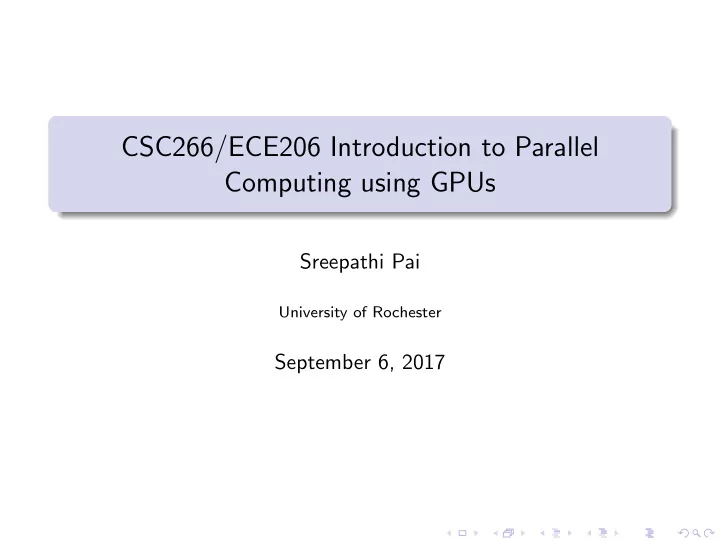

CSC266/ECE206 Introduction to Parallel Computing using GPUs Sreepathi Pai University of Rochester September 6, 2017
Outline Organization 1 Performance Metrics 2 Program Optimization 3
Outline Organization 1 Performance Metrics 2 Program Optimization 3
People Lectures: Dr. Sreepathi Pai E-mail: sree@cs.rochester.edu Office: Wegmans 3409 Office Hours: By appointment Labs: Dr. Alex Page E-mail: alex.page@rochester.edu
Places Class: CSB 523 M, W 1650–1805 Course Website: https://cs.rochester.edu/~sree/fall-2017/csc-266 Blackboard: Announcements, Assignments, etc. Piazza: TBA
References No required textbook for the class Useful to have a book on architecture as a reference But this is not a computer architecture class Links to manuals, papers, etc. will be provided Feel free to search for them
Project Expectation You will demonstrate your mastery of the course goals. Specifically, for a program, you will: Identify parallelization opportunities Implement programs on the GPU Optimize programs on the GPU
Outline Organization 1 Performance Metrics 2 Program Optimization 3
Metrics we’re interested in Latency Time units: 1 µ s or 1000000 cycles Lower is better Throughput Rate: FLOPS or Instructions per Cycle (IPC) Higher is better Other interesting performance metrics Power (Watt) Energy (Joule)
Applications where latency is crucial Audio/Video MP3 players MPEG4 players VoIP (e.g. Skype) Games Multi-user gameplay Responsiveness Servers Search Engines Web applications
Applications where throughput is crucial Audio/Video MP3 encoders MPEG4 encoders Games Frame rate Scientific Applications Molecular Dynamics Finite-element Code Servers Search Engines Web applications
Better performance can open up new vistas
Outline Organization 1 Performance Metrics 2 Program Optimization 3
Principles of Optimization Work less Work cheaply Work concurrently applies to programs only
Layers Algorithm Implementation C/C++ Compiler Assembly Assembler Binary Operating System Language Runtime Process Instructions Processor
Layers for Java javac Class Files Java Byte Code Java Virtual Machine Assembly Assembler Operating System Language Runtime Binary Process Instructions Processor
Conclusion Two metrics of interest Latency Throughput Unit of work is the instruction Principles of optimization Use fewer instructions Use cheaper instructions Concurrent instruction execution C/C++ chosen for Fewer abstractions Easier understanding
Acknowledgements Images of Toy Story and GMail from Wikipedia
Recommend
More recommend